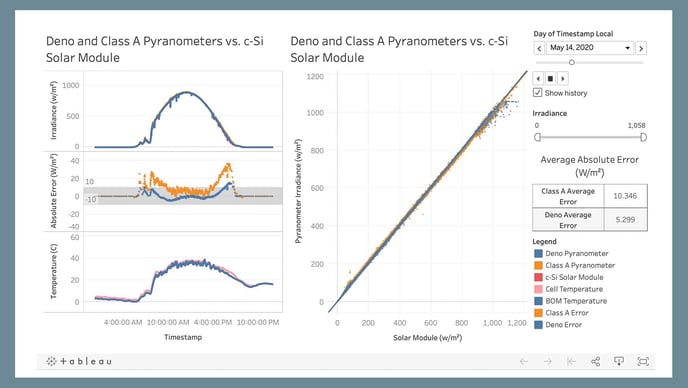Leraging Deno Pyranometer Technology to Optimize Solar Performance Benchmarking

The Denowatts team asked, “How do we demonstrate the accuracy of our pyranometers and their effectiveness for benchmarking solar?” While ISO 9060 is the leading standard for classifying the effectiveness of a pyranometer, we sought to better demonstrate the Deno sensor’s accuracy in real-world conditions. These include varied and unstable light levels, spectral composition, incident angle, temperature, condensation, and soiling. We then conducted a long-term test to compare the Deno pyranometer and a Class A flat spectrum pyranometer with a typical solar module.
Using a standard Deno, we removed one of the two pyranometers and replaced it with the input of a Class A flat spectrum pyranometer. We then connected a typical crystalline solar module with a shunt resistor to the Deno’s reference channel. This allows us to treat the solar module like a giant reference cell, and compare its responsivity against those of the Deno and Class A pyranometers. The logging intervals apply the typical Deno schedule: 5-second samples and 1-minute records during normal daylight conditions.
The solar module is set at 20-degrees inclination and 180-degrees azimuth. The Deno and the Class A pyranometer are mounted adjacent to one another in the same plane as the solar module. We adhered our back of module temperature sensor (Tbom) to the solar module, and connected that to the Deno sensor to demonstrate the accuracy of our Tcell data. Finally, we set the Class A pyranometer and solar module responsivity to align the calibrations of all three readings.
The raw data is openly available in Tableau Public, both for viewing and data interaction. To get started, press the Play button on the date filter. Then adjust the irradiance level filter, navigate to the most current date, and simply click any data point in the error graph to view the full range of data. We hope you find this demonstration helpful to better understand Deno sensor functionality and accuracy, as well as how to leverage Tableau as a Business Intelligence tool. The data in this analysis will be updated periodically on an ongoing basis. Please send us your questions, feedback, or a request for a live demonstration to: support@denowatts.com.
About Denowatts Solar, LLC: “Are my solar assets performing as they should?” The Deno technology answers this question.
Denowatts Solar, LLC is a solar performance benchmarking and analytics service. An Accredited ISO/IEC 17025:2017 Calibration Laboratory, Denowatts Solar’s mission is to deliver the industry’s most reliable and accurate benchmarking data through the patented Deno sensor. The Deno sensor replaces traditional weather stations and cost-effectively scales to assets of any size. Denowatts is a plug-in data service to any monitoring company that offers a best in class Business Intelligence (BI) platform for performance analysts and data scientists. Denowatts employs IEC 61724-series international standards to manage and report performance metrics for asset owners and managers, independent engineers, and financiers.
